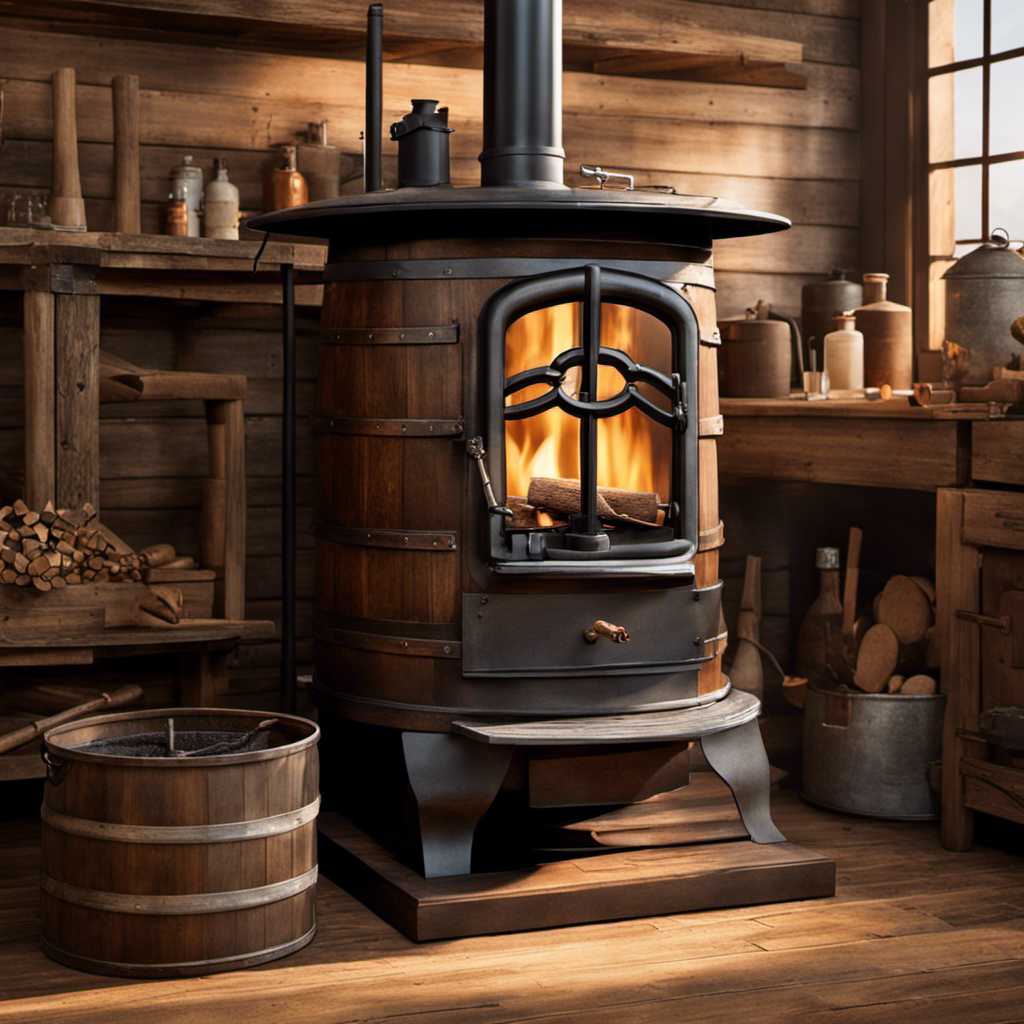I have always wanted to keep warm during the cold winter nights. That’s why I took on a DIY project to create a wood stove using a barrel.
With some simple tools and a bit of know-how, I transformed that old barrel into a reliable source of heat.
In this article, I’ll guide you through the process, from selecting the perfect barrel to ensuring safety and maintenance.
Let’s ignite your creativity and warmth, shall we?
Key Takeaways
- Choose a durable barrel made of steel for longevity and heat resistance.
- Prepare the barrel by emptying it, cleaning the interior, and allowing it to air dry.
- Use thick, heat-resistant materials for the firebox and determine its size based on heating needs and barrel size.
- Install a tightly sealed door, ventilation system, and chimney for proper airflow control and heat output.
Selecting the Right Barrel
I’m currently researching and comparing different barrel options to find the right one for constructing a wood stove.
When it comes to barrel types, there are a few key factors to consider. Firstly, you’ll want to choose a barrel that’s made from a durable material such as steel, as this will ensure longevity and heat resistance.
Additionally, the size of the barrel is important, as it will determine the amount of heat the stove can produce. The larger the barrel, the more wood it can hold, resulting in a longer burn time and greater heat output. However, it’s important to balance size with the available space in your desired location.
Preparing the Barrel for Conversion
To prepare the barrel for conversion, I’ll need to remove any existing residue or contaminants. This step is crucial to ensure the safety and efficiency of the wood stove. Here are the necessary steps:
-
Empty the barrel: Remove any leftover contents, such as liquids or solids, to create a clean starting point.
-
Clean the interior: Scrub the inside of the barrel using a mixture of hot water and detergent. Use a brush to remove any residue or build-up.
-
Rinse and dry: Thoroughly rinse the barrel with clean water to remove any detergent or remaining contaminants. Allow it to air dry completely before proceeding with the conversion process.
Safety precautions should always be taken during barrel cleaning. Wear protective gloves and eyewear to avoid any contact with chemicals or sharp objects. Additionally, work in a well-ventilated area to minimize exposure to fumes.
Building the Firebox and Flue System
I’ll need both a firebox and a flue system to properly build my wood stove. The firebox design is crucial for efficient combustion and heat transfer. It should be made of thick, heat-resistant materials, such as steel or cast iron, to withstand high temperatures and prevent warping. The size of the firebox is determined by the heating needs and the size of the barrel. A larger firebox allows for longer burn times and more heat output. The flue system consists of the flue pipe and chimney, which are responsible for venting the smoke and gases out of the stove. The flue pipe installation should be done carefully to ensure proper draft and prevent leaks. It is important to follow the manufacturer’s instructions and local building codes when installing the flue system.
| Firebox Design | Flue Pipe Installation |
|---|---|
| Heat-resistant materials (e.g., steel, cast iron) | Proper draft and ventilation |
| Size based on heating needs and barrel size | Follow manufacturer’s instructions |
| Efficient combustion and heat transfer | Prevent leaks and ensure safety |
Installing the Door and Ventilation System
Sometimes, I open the door and turn on the ventilation system to allow fresh air into the wood stove. This is an important step in maintaining proper airflow and ensuring efficient combustion.
In addition to this, there are a few other crucial aspects to consider when installing the door and ventilation system in a wood stove:
-
Installing the chimney pipe: The chimney pipe is responsible for directing the smoke and gases out of the stove and safely venting them outside. It should be securely attached to the stove and properly insulated to prevent heat loss.
-
Sealing the door tightly: A tightly sealed door is essential for preventing air leaks and ensuring optimal heat output. Gaskets or rope seals can be used to create a tight seal around the door, preventing any unwanted air infiltration.
-
Ventilation system setup: The ventilation system, including air vents and dampers, should be properly installed to control the airflow into the stove. This allows for efficient combustion and helps regulate the temperature inside the stove.
Safety Tips and Maintenance for Your Homemade Wood Stove
I regularly inspect and clean my homemade wood stove to ensure its safety and proper maintenance.
Proper placement of a wood stove is crucial for its efficient functioning and to prevent any potential hazards. When choosing a location for your wood stove, make sure it’s placed on a non-combustible surface, away from any flammable materials. It should also be positioned in a central area of your home to distribute heat evenly.
Cleaning and maintaining your wood stove is essential for its longevity. Start by removing ashes and debris regularly to prevent any blockage in the chimney or exhaust system. Inspect the stovepipe, stove door gaskets, and firebricks for any signs of wear and tear, and replace them if necessary.
Additionally, have your chimney inspected and cleaned annually by a professional to ensure its efficiency and safety.
Frequently Asked Questions
Can I Use Any Type of Barrel for Making a Wood Stove?
I can use different barrel types for making a wood stove. However, there are pros and cons to consider. Some barrels may have better heat retention, while others may be more durable.
Do I Need Any Special Tools to Prepare the Barrel for Conversion?
I don’t need any special tools for the barrel conversion process. It’s a straightforward DIY project that can be done with basic tools like a drill, angle grinder, and saw.
How Can I Ensure Proper Airflow in the Firebox and Flue System?
To ensure proper airflow in the firebox and flue system, I’d suggest using techniques like adjustable air vents and a chimney damper. Troubleshooting airflow issues might involve cleaning the flue or checking for obstructions.
What Type of Door and Ventilation System Should I Use for My Homemade Wood Stove?
To ensure proper ventilation in a homemade wood stove, it is important to choose the right type of door and ventilation system. Different types of insulation for the door can help maintain heat, while troubleshooting common ventilation issues is crucial for optimal performance.
Are There Any Specific Safety Precautions or Maintenance Tasks I Should Be Aware of for My Homemade Wood Stove?
When it comes to homemade wood stoves, safety precautions and maintenance tasks are of utmost importance. From proper ventilation to regular cleaning, staying aware and taking necessary steps ensures a safe and functional wood stove.
Conclusion
In conclusion, crafting your own wood stove from a barrel is a rewarding project that can provide warmth and comfort.
By carefully selecting the right barrel, preparing it for conversion, and building the necessary firebox and flue system, you can create a functional and efficient heating solution.
Remember to prioritize safety by installing a proper door and ventilation system, and regularly maintain your homemade wood stove.
As the saying goes, ‘Where there’s smoke, there’s fire,’ so ensure your stove operates smoothly and enjoy the cozy ambiance it brings.
Growing up surrounded by the vast beauty of nature, Sierra was always drawn to the call of the wild. While others sought the comfort of the familiar, she ventured out, embracing the unpredictable and finding stories in the heartbeat of nature.
At the epicenter of every remarkable venture lies a dynamic team—a fusion of diverse talents, visions, and passions. The essence of Best Small Wood Stoves is crafted and refined by such a trio: Sierra, Logan, and Terra. Their collective expertise has transformed the platform into a leading authority on small wood stoves, radiating warmth and knowledge in equal measure.











